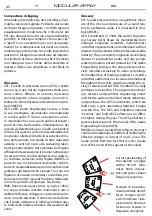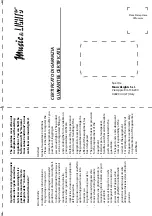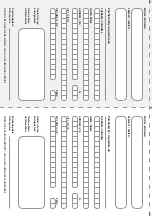
39
MODULAR ARRAY
EN
IT
BREVI CENNI DI ACUSTICA
La diffusione del suono in un ambiente ha lo
scopo di soddisfare l’ascolto da parte di un certo
numero di persone ed è legata a diversi fatto-
ri dipendenti dall’ambiente stesso (forma della
sala, volume, ecc.), dal numero e dalla posizione
degli ascoltatori, dalla natura della sorgente so-
nora (esecuzioni musicali o parlato, riprodotti da
registrazione o dal vivo) e dal livello di rumore
presente nell’ambiente.
Efficienza
La pressione sonora di un diffusore (SPL misu-
rata in dB) dipende da tre fattori: la sua efficien-
za, le sue dimensioni ed il suo utilizzo in com-
binazione con altri diffusori. L’efficienza, cioè la
quantità di energia prodotta dall’amplificatore
trasformata in suono, determina il volume che
si può ottenere da un amplificatore di una data
potenza. Diffusori molto efficienti, possono far
sì che un amplificatore da 50W produca mag-
gior volume di uno da 100W usato con diffusori
meno efficienti.
Impedenza
Una delle caratteristiche elettriche di un diffu-
sore è l’impedenza (la resistenza opposta alla
corrente alternata). Sia la resistenza che l’impe-
denza si misurano in Ohm; l’impedenza varia al
variare della frequenza quindi ne consegue che
le diverse frequenze possono essere rese con un
SPL diverso.
Un diffusore con impedenza superiore a quella
minima di funzionamento del finale può essere
utilizzata a scapito della potenza erogata, men-
tre è bene evitare collegamenti con diffusori che
hanno impedenza minore di quella minima di
lavoro del finale di potenza.
Usando sistemi più complessi (ad esempio più
speakers collegati allo stesso finale) bisogna fare
in modo che il valore totale dell’impedenza de-
gli altoparlanti sia corrispondente a quella mini-
ma di funzionamento del amplificatore.
Possiamo avere due tipi di collegamento: in se-
rie o in parallelo. Collegare in serie due altopar-
lanti significa unire un terminale positivo ed uno
negativo dei due e collegare all’amplificatore i
BRIEF NOTES ON ACOUSTIC
Diffusing sound into an environment means to
distribute sound signals to a given audience and
the results are dependent on several ambient
factors (room shape, volume, etc.), the number
of the people present and their precise location,
the type of sound source (live or recorded mu-
sic or speech), and the level of the background
ambient noise.
Efficiency
Sound pressure (SPL) of a loudspeaker depends
on three factors: efficiency, dimensions and use
in combination with other loudspeakers. Effi-
ciency, the quantity of energy generated by the
amplifier transformed into sound, determines
the volume that can be obtained by an ampli-
fier of a given power rating. A 50W amplifier
combined with highly efficient loudspeakers
may be able to produce a higher volume than
a 100W amplifier combined with less efficient
loudspeakers.
Impedance
One of the electrical features of a loudspeaker is
its impedance (resistance to the passage of al-
ternate current). Both resistance and impedance
varies at different frequencies so different fre-
quencies can be delivered with different sound
pressure levels.
In some cases, confusion may arise when com-
bining impedance values of power amplifiers
with those of loudspeakers.
Adapting the output impedance of the amplifier
to the loudspeaker’s input impedance means
that all the energy from the amplifier will be
transferred to the speakers with no signal losses,
so that the system works in optimum conditions
(and the risk of damage is minimised).
A loudspeaker having an higher impedance
than power amplifier’s may be used, although
this will result in a power reduction; loudspeak-
ers with an impedance lower than amplifier’s
minimum load, must not be connected. If more
complex systems (e.g. several speakers con-
nected to the same amplifier) are adopted, you
must be sure that the overall speaker imped-
Содержание MA605A
Страница 1: ... MANUALE UTENTE USER MANUAL MODULAR ARRAY ACTIVE PASSIVE MODULE FOR LINE ARRAY IT EN ...
Страница 45: ......
Страница 46: ......
Страница 47: ......










































